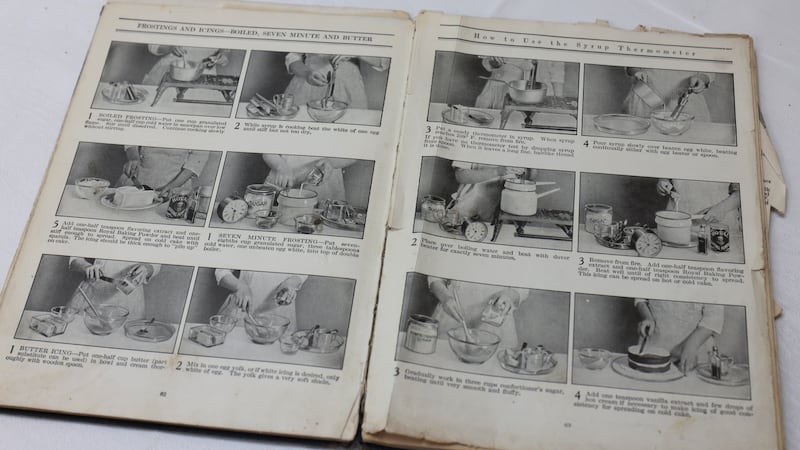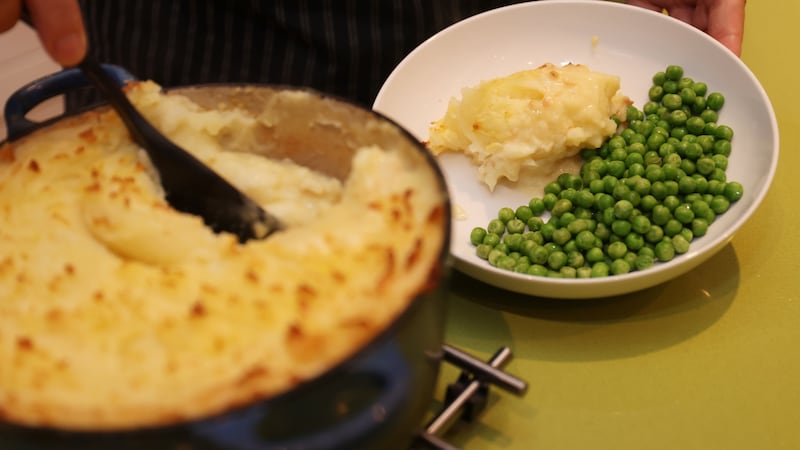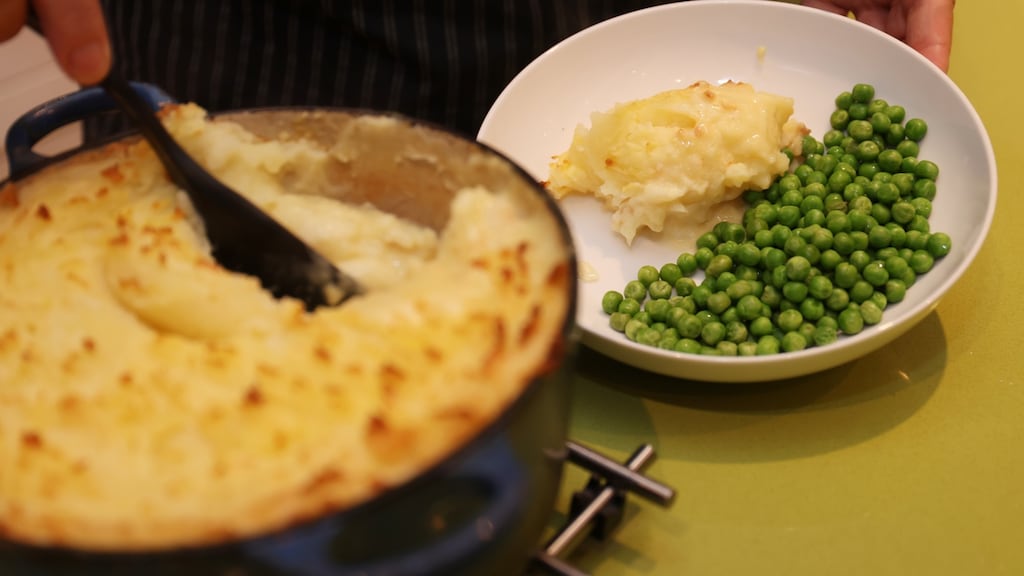I am in possession of one of my grandmother’s cookbooks, a well-used copy of Any One Can Bake, compiled in 1929 by the Royal Baking Powder Co, New York City. I wonder where it came from, and what she cooked from it. I also wonder how it might have influenced, and added to, the food traditions and flavour memories she passed along to her eight children, memories that continue to percolate down through the generations.
Granny died when I was six. I recall the packet of Marietta that fuelled our journeys from Dublin to Kilkenny, and the kitchen dominated by Aga and mangle, but not the food she prepared for us. Though roast beef does resonate, and crusty blaas with centres of air – imported from Waterford – and the lip-numbing treat of an ice-pop from the family shop savoured in the sunny yard.
I know from my mother that granny spent much of her life quietly producing food for her family and others, whatever and whenever they wanted to eat. One aunt eventually took responsibility for Sunday’s main meal. And though I never met this grandfather I know that his weekly culinary prediction, on passing the mould of dissolved gelatine on a Saturday night, was: “aaah...burnt roast and jelly for a change”.


Over on Griffith Avenue, Dublin, we watched jealously as Pop, my other grandfather, was cut the largest wafer off the block of HB vanilla. While Aunty – my grand-aunt and step-grandmother – terrified us with her ability to cook cabbage beyond an inch of its life.
The strongest food memory from this house, however, is fresh turnover bread sliced almost paper-thin, spread with warm butter from a glass dish, and served with strong tea, all smoked in the fug of their Players Navy Cut.
Tastebuds
My father’s tastebuds were shaped by dual Dublin and Wexford heritages, but we baulked at some family favourites. Despite his declarations of their deliciousness, pressed tongue, the pale mess that was coddle, and the brawn under the pudding bowl in the fridge, formed from the pickings of a boiled pig’s head, would never make it on to our plates.
He spent holidays with his uncles at their farm near Tara Hill, where bread was baked and eaten warm, probably the same recipe his mother, and then his aunt, used at home.
In my childhood pots of their own potatoes were still tumbled on to the scrubbed wooden table, alongside butter and salt, and a lump of fatty bacon or turnips.
The turnips also fed cattle, and we took turns macerating them in the barn’s cast-iron pulper. Even a day thinning a field of orange-fleshed swedes didn’t change my opinion that they were wasted on livestock. They even feature in the dinner I chose for my welcome home and celebration meals: steak pie, tender beef in gravy under a pastry lid, accompanied by peas, roast potatoes and peppery mashed turnips.
This was just one of many wonderful meals mum made, often echoing those prepared by her own mother and earlier generations. The meat order book from my great-grandfather’s house between 1904 and 1916 pairs easily with our brown and Irish stews, chops, steak and kidney, and stuffed breast of lamb.
It may have been her sweet tooth, and an effort to recreate her own childhood favourites, some from that American cookbook, that ensured a cake tin was always filled, with orange, coffee, and jam sponges, boiled fruitcakes, and that we had a dessert every day.
We ate milk and steamed puddings, floating islands, apple sponge, banana and custard, chilled until it set, with a squeeze of Jif lemon to stop the bananas browning, and of course jelly. Until she finally mutinied, she was expected to conjure up the perfect baked Alaska for birthdays, even her own.
Small budget
Like most women in the 1970s and 1980s, mum summoned up daily menus from a small budget. Mince stew was seasoned and thickened with a packet of beef and vegetable soup; adding a tin of beans, and serving it with rice, transformed it into “hash”.
A set of Marguerite Patten cookery books that produced a wonderful devil’s food cake also gave us pennywise chicken pie, so pennywise it contained no chicken, just a tin of poultry-flavoured soup.
Summers in north Wexford brought additional challenges. Before the arrival of electricity and refrigeration Spam played a starring role, and tinned pies reheated in a volatile gas oven. My sisters and I still speak with horror about “the year of the meat-loaf”, a reviled pink concoction eaten hot, and then cold.
How we loved Friday nights when the scrunch of wheels on stones heralded dad’s appearance, bringing fresh food, boxes of fruit from Smithfield, or prepared by Rita, his favourite on Moore Street, and on rare occasions bags of hot vinegary chips from Courtown.
Mum was an adventurous home cook, which wasn’t always appreciated. Curry was packed with swollen raisins, with sides of desiccated coconut, sliced bananas, and Sharwoods mango chutney. And we were early Irish inductees to spaghetti Bolognaise. I blame an initial aversion to Italian cuisine on the vomit-odoured “Parmesan” shaken from a small drum.
Time – and money –saving gadgets and ingredients were embraced. Granny’s beef tea and broth were replaced by Oxo cubes, dissolved in hot water for an after-school snack. And her progression from chip-pan to deep-fat-fryer allowed quicker, and safer, production of melt-in-the mouth onion rings and apple fritters.
A temperamental pressure cooker regularly hit the roof. She froze seasonal vegetables and special offers until we gagged at the mention of green beans. We yearned for chocolate Yoplaits, but got bitter plain yoghurt, fermented overnight in a circular contraption bought at a bring-and-buy sale.
And while the Breville sandwich-maker transformed our lunchtimes forever, the microwave changed her entire day. By the mid-1980s she could cook and plate seven dinners by 10am, cover each with cling film; to be heated for three minutes on full, whenever we returned from school, college or work.
Fried bread
Dad, a skilled peeler, slicer and carver, always helped in the kitchen. However, his culinary attempts were usually restricted to making fried bread from the drippings of the grill pan, or explaining how tomato and onion sandwiches were improved by a sprinkling of salt and vinegar.
Yet, to my mother’s disgust, we once voted Saturday dinner our favourite. This was the mince he reheated and presented, with under-cooked potatoes and as much butter as we wanted, when she went “to town”.
He was a late developer. On retirement in the 1990s he was gifted a book on Indian cooking by my eldest sister, who had moved to London’s culinary cosmos. With an eye for the exact, a proponent always of “measure twice, cut once”, he toasted spices and blended pastes to produce restaurant-quality banquets for family gatherings. His prawn curry, with a chickpea alternative for the vegetarians, is already being cooked by his grandchildren.
They have still to master his “split-toast” sandwiches, or the beloved tomato soup that their grandmother produces in vats but nobody else can recreate.
That soup wasn’t one she whizzed up in our own childhood, but a WhatsApp shout-out to my four sisters brings other recollections; of colcannon-dotted with coins at Halloween, jam-making in Wexford with the blackberries we picked, liver in bacon rolls, or smothered in ketchup to hide the taste, sinks filled with fresh mackerel, and the essential Christmas bread sauce.
An old recipe notebook contains other triggers. It, like my grandmother’s Any One Can Bake, has a McDonnells Good Food Christmas leaflet tucked between its pages. My sister’s and mother’s handwriting record savoury pancakes, pavlova, Shrewsbury biscuits, tea brack. I make the brown bread recipe to see if is the shallow moist bread of our youth. It’s not.
Wastefulness
My one entry is for Danish pastries, a reminder of our brief teenage dalliance with yeast baking. Confusion between fresh and dried yeast measures culminated in two of us dragging an expanding bag of dough down our road, to be stuffed, bubbling and complaining, into a bin outside the local pub; all to avoid a maternal conniption over our idiocy and wastefulness.
So what from my own repertoire will be passed on to the next generation?
Many of my own recipe books, like our current rota of dinners, trace more exotic food traditions than ours: Mexican, Japanese, Mediterranean, Chinese, Middle Eastern. However, it is a simple homegrown fish pie, pasty and unexciting but comfort-laden, which wins the domestic vote.
My family don’t realise its legacy. There is no recipe, but mum confirms its origins in my grandmother’s kitchen. Living inland, smoked fish frequently alternated for fresh, which only arrived late on Thursday nights. Granny served it in an onion sauce topped with mashed potato. My mother used smoked coley, poaching the fish in milk with a bay leaf, and baking to a crisp bubbling top in the oven.
More recently I’ve used undyed smoked haddock and fresh cod, and blended the onions into the sauce when my children were small. They, I am sure, will make their own version.
SMOKED FISH PIE
I usually cook this by eye and instinct, so these are notes for one cooked recently in a cast-iron casserole (8in/20cm diameter), enough for four.
Ingredients
650g skinned smoked white fish fillets, or a mix of smoked and fresh.
1 large onion (not red), sliced or chopped.
400 mls of milk
A bay leaf or two
2 tbsps butter
2 tbsps flour
1 kg of Roosters peeled, boiled, and mashed with a little milk and butter.
Method
1. Poach the fish in the milk with the bay leaves and a few twists of pepper until barely cooked (about five minutes). Remove the fish and set aside. Pour milk into a jug. Rinse out pot.
2. Sweat onions in butter until soft, but not browned. Add flour, stirring until blended. Cook gently for two minutes.
3. Discard bay leaf, and gradually add infused milk, stirring until you get a smooth sauce (except for the oniony bits). Simmer for about four minutes.
4. Taste and season, remembering smoked fish is salty.
5. Add fish pieces (check for stray bones). Depending on what smoked fish you use, the resulting mix will range from primary orange to pastel.
6. Top with the mash. Run a fork dipped in butter over top and bake (200 degrees /fan 180) until crisped, and the sauce bubbles through. Serve with green peas.















